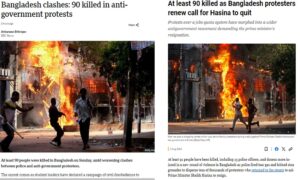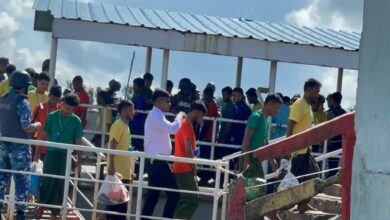What is the world media saying about the conflict and loss of life in Bangladesh?
The international media has reported the loss of many lives during the non-cooperation movement called by the anti-discrimination student movement to demand the resignation of the government.
BBC, Reuters, Aljazeera, NDTV and other media have mentioned the unprecedented violence in the All-Out Non-Cooperation Movement.
At least 90 people were killed in Bangladesh on Sunday (August 4) amid escalating clashes between police and anti-government protesters, according to a BBC report. Unrest has arisen as students have announced a non-cooperation movement demanding the resignation of Prime Minister Sheikh Hasina.
The media also mentioned the killing of 13 policemen in an attack by thousands of protesters on a police station in Sirajganj.
According to the report, the police used tear gas and rubber bullets to disperse the protestors in different parts of Bangladesh on Sunday. Authorities have again imposed curfews across the country to quell protests. Last month, the students’ protest started demanding cancellation of quota in government jobs, but now it has turned into an anti-government movement.
A policeman, who did not wish to be named, told news agency AFP, “The entire capital has become a battlefield.” Several thousand protesters set fire to cars and motorcycles outside a hospital.
The New York Times, an influential American newspaper, had a headline yesterday about the situation in Bangladesh, “Curfew issued again in Bangladesh after dozens of deaths in protests”. According to reports, at least 40 people were killed in clashes between security forces and protesters on Sunday. Curfew has been issued again. The Internet has been clamped down.
Middle East-based media Al Jazeera reported that at least 91 people, including 13 policemen, have been killed in renewed violence in Bangladesh. Police fired tear gas and stun grenades to disperse tens of thousands of protesters. The protesters demanded Sheikh Hasina’s resignation.
According to the report, police and doctors have reported deaths in the capital Dhaka and the northern districts of Bogra, Sirajganj, Pabna and Rangpur as well as Magura in the west, Comilla in the east and Barisal and Feni in the south on Sunday. Earlier in July, at least 200 people died in the protests, according to the newspaper.
Additional Deputy Inspector General of Bangladesh Police Bijay Basak said that the attack on the police took place at Enayetpur police station in the northwestern city of Sirajganj. The identity of the attackers is not known.
India’s NDTV reports that the country’s embassy in Dhaka has asked Indian citizens living in Bangladesh to be vigilant after 91 people were killed in clashes between protesters and activists of the ruling Awami League.
According to the report of the American news agency AP, about 100 people were killed and hundreds of people were injured in the new anti-government protests in Bangladesh on Sunday. The report mentioned that the agitators will continue the program to demand the resignation of Prime Minister Sheikh Hasina.
According to the report of the British news agency Reuters, at least 91 people including 13 policemen were killed and hundreds were injured in the clashes in Bangladesh on Sunday. The report also mentions that it is the highest single-day death toll in Bangladesh’s recent history.
According to the report, her critics and human rights organizations have accused Sheikh Hasina of using excessive force to suppress the ongoing movement in Bangladesh. However, Sheikh Hasina and her ministers have denied this allegation.





